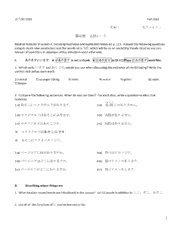
L4GrammarSheetF14.pdf (PDFy mirror) PDF
Preview L4GrammarSheetF14.pdf (PDFy mirror)
日本語1010 Fall 2014 名前: セクション: 第四課 文法シート Read all material in Lesson 4, including footnotes and Expression Notes on p. 113. Answer the following questions using as much new vocabulary (and the words on p. 127, which will be on an upcoming Vocab. Quiz) as you can. Answer all questions in Japanese unless directions state otherwise. I. あります/ います *があります is not a chunk. Xはあります or (Xは) Placeにあります work fine. 1. Which verb, いますandあります, would you use when discussing the existence of the following? Write the correct verb below each word. 1) animal 2) younger sibling 3) trees 4) water 5) ghost 6) robot 7) flower 2. Compare the following sentences. When do you use them? For each item, write a question to elicit that response. びょういん 1-‐a) あそこにマクドナルドがあります。 2-‐a) 病 院じゃありません。 1-‐b) マクドナルドはあそこにあります。 2-‐b) 病院がありません。 1-‐c) マクドナルドはあそこです。 2-‐c) 病院はありません。 ✕ マクドナルドはあそこにです。 ✕ あそこにマクドナルドです。 3-‐a) バージニアに何がありますか。 4-‐a) 明日はテストです。 3-‐b) バージニアはどこにありますか。 4-‐b) 明日テストがあります。 3-‐c) バージニアのどこにありますか。 4-‐c) 明日テストをします。 II. Describing where things are 1. What location nouns/words are introduced in this Lesson? List 12 words in addition to ここ、そこ、あそこ. 2. List all of the functions of にyou’ve learned so far: 1 3. Examine the following sentences. For each sentence, write a question to get elicit that sentence/response. こうえん うし 1) 公園はあのデパートの後ろです。 2)公園はあのデパートの後ろにあります。 3)デパートの後ろに公園があります。 4. Look around you, choose something you see, and describe where it is. Do the same for two other things. Write your answers below. a. b. c. 5. Fill in the blanks with an appropriate particle. If no particle is needed, write an X. Be prepared to explain why you chose one particular particle over another. There may be more than one way to complete each sentence. せんせい いま 1) 先生( )今( )オフィス( )います。 てがみ 2) ロバート:スーさん、たけしさん( )手紙( )どこ( )ありますか。 つくえ スー: ああ、あの手紙ですか。メアリーさん( )机( )そば( )ありますよ。 ほんや きっさてん まえ 3) トイレは本屋( )上( )喫茶店( )前( )あります。 にほんご 4) いつ( )日本語( )テスト( )ありますか。 か もの 5) どこ( )よく買い物( )しますか。 いぬ 6) どこ( )犬( )いますか。 うち 7) 家( )となり( )デパート( )アルバイト( )しませんか。 あ 8) だれ( )メアリーさん( )会いましたか。 III. Past Tense – Completed/finished action 1. Practice changing all the verbs introduced in L3 and L4 into the past tense, affirmative and negative. Write examples of the past tense, affirmative and negative for two verbs each from L3 and L4. Verb (dictionary form) Past Tense (affirmative) Past Tense (negative) (L3-‐1) (L3-‐2) 2 Verb (dictionary form) Past Tense (affirmative) Past Tense (negative) (L4-‐1) (L4-‐2) 2. Complete the sentences below using the new vocabulary in each item. Challenge yourself! Create longer, more complex sentences in which you include at least one negative. こども 1)子供の時_______________________________________________________________________________。 せんしゅう 2)先週の金曜日に____________________________________。 きょねん 3)去年__________________________________________。 せんせい 4)先生は____________________________________でしたか 。 きのう 5) どうして昨日______________________________________ 。 IV. たくさん V. 〜時間 1. Make corrections to the sentences below. 1)土曜日にデパートでかいものたくさんをしました。 2)私はよくデパートで一時間にかいものをしました。 3) たくさん学生は週末にパーティーに行きます。 2. Complete the following sentences using the words provided. Use a variety of sentence structures. 1) [たくさん] _______________________________________________________________________________。 2) [・・・時間] ______________________________________________________________________________。 VI. 「と」 VII. 「も」 VIII. Double Particles 1. What’s the function ofと? What does it connect, and what does it NOT connect? 2. Read p. 111 carefully and explain how they are different. わたし としょかん 1) 私は図書館で勉強しました。 2) 私も図書館で勉強しました。 3) 私は図書館でも勉強しました。 4) 私は図書館では勉強しましたけど・・・。 5) 私も友だちと図書館で勉強しました。 6) 私は友だちとも図書館で勉強しました。 3
